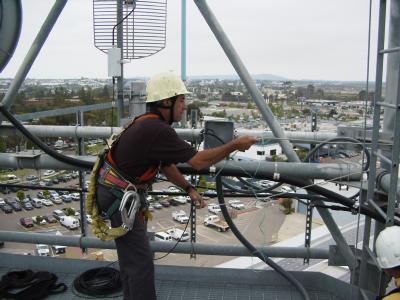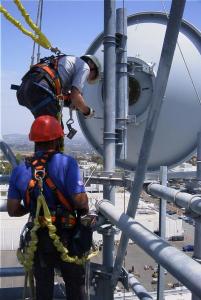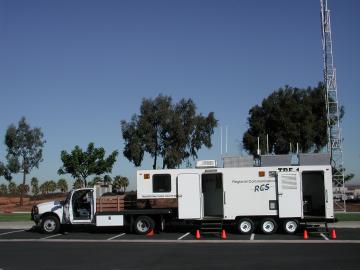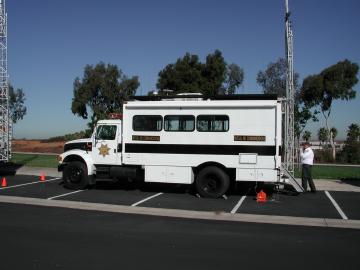|
November 30, 2006
Public Safety Agencies Begin Work on an HPWREN-like System for
Southern California
For more than five years, the HPWREN team has been working with
first responders in the San Diego area to better understand how
high-speed wireless data networking can assist with public safety
aspects in hard-to-reach areas for both persistent and ad-hoc
connections. This participation has involved multiple incident
management activities over the years, and has not only benefited
the HPWREN project, but also the Public Safety community of southern
California. Many lessons were gleaned from the collaborative efforts.
These collaborations predominantly include the California
Department of Forestry and Fire Protection (CDF) and the San Diego
County Sheriff's Department.
Most recently, the San Diego City Police Department, the San
Diego City Fire and Life Safety Department, the San Diego County
Sheriff, and the California Department of Forestry and Fire Protection
formed a formal consortium to capitalize on the research findings
of HPWREN's work in the public safety arena. The consortium's primary
goal is to build a large-pipe data communications system modeled
after the HPWREN program. This new network is currently being funded
by several public safety and Homeland Security grants.
More than eight million dollars have been allocated to begin the
build-out of the HPWREN-like system in southern California. The
Communications Command and Control (3C's) Network, when constructed,
will allow multiple agencies to communicate with one another -
rather than each agency having its own system. The digital communication
system will integrate Voice-over-IP, for both phone and FAX needs.
Additionally, video conferencing as well as real-time sensor telemetry
and data integration will be utilized, once the system is in place.
It is anticipated that phase one if the new multi-agency system
will be in place early in 2007. The project is built in five phases
which will connect all the public safety agencies in San Diego and
Imperial counties, and provides access into Riverside and San
Bernardino counties. Negotiations are progressing for connectivity
into Arizona as well. Phases one and two are currently funded and
in construction.

|
Installation work on a San Diego County tower by RCS and HPWREN staff.
|

|
HPWREN and the work done in collaboration with Public Safety by
HPWREN have provided Public Safety with a model to build from. The
HPWREN network will enable the construction of a 'first of its kind'
wireless network that will keep this region on the national forefront
of technology advancements in interoperable communications.
"To assure long-term continuity of high-performance and reliable
data networking, it is important that the technology gets transformed
into agency-owned critical infrastructure environments that the
public safety agencies need," says Hans-Werner Braun, HPWREN Principal
Investigator. "The creation of the 3C network and its support of
multiple agencies are precisely in line with the next steps needed."
The San Diego-Imperial County Regional Communications System
(RCS) is a wireless interoperability communications platform. Using
state-of-the-art technologies and innovative direction, the RCS is
and has been a model for governance and technologies in Public
Safety communications nationwide. The RCS consists of wireless voice
and data communications over a wide range of radio spectrum. Most
public safety and public service agencies in San Diego County and
Imperial County participate in the RCS. This network provides service
to 214 agencies in a two-county service area of approximately 9,000
square miles, including 185 miles of international border. The RCS
typically handles approximately 3,000,000 user transmissions (calls)
each month. Growth of agencies using the RCS has exceeded expectations.
The new 3C network adds a high-speed data component in addition to the
existing RCS infrastructure.

|

|
|
Mobile transmitter site containing the same infrastructure
equipment used at a remote fixed-installation transmitter site
|
Incident Command Post vehicle
|
Working with first responders allows HPWREN researchers to
experiment with and demonstrate rapid deployments of networking
technologies, as well as how best to create and maintain high-speed
data connectivity under difficult circumstances, such as large-scale
wildfires. The team deployed high-speed network communication
capabilities at six major wildfire Incident Command Post (ICP)
sites: Coyote Fire in July 2003, Mataguay Fire in July 2004, Eagle
Fire in May 2004, Volcan Fire in September 2005, the Border 50 Fire
in October 2005, and the Horse Fire in July 2006.
Additionally, HPWREN researchers worked with the community to
prepare connectivity for three California Department of Fire and
Forestry (CDF) pre-designated ICP sites: Dos Picos, Puerta La Cruz,
and Potrero. The team also participated with CDF firefighters in
two of their annual exercises: 2005 at Lake Hodges and 2006 at Dos
Picos.
Permanent CDF sites currently connected to HPWREN include the
Red Mountain Fire Station, the La Cima Fire Camp, the Ramona Air
Attack Base, Gillespie Helitak Base, and the Puerta La Cruz
Conservation Camp.
In addition to high-speed network access, ICP and permanent CDF
sites connected to HPWREN also have access to real-time video, still
cameras, and meteorology sensors, such as those atop Mount Laguna
and Lyons Peak. Included with the suite of meteorology sensors is
a real-time alert system that automatically pages first responders
when environmental conditions of concern are present. Functionalities
like this are expected to be integrated into the new public safety
consortium network.
Chris R. Hinshaw
Manager, Wireless Services Division
San Diego County Sheriff's Department
San Diego-Imperial County Regional Communications System
 back to top
back to top
 back to HPWREN news
back to HPWREN news | 
